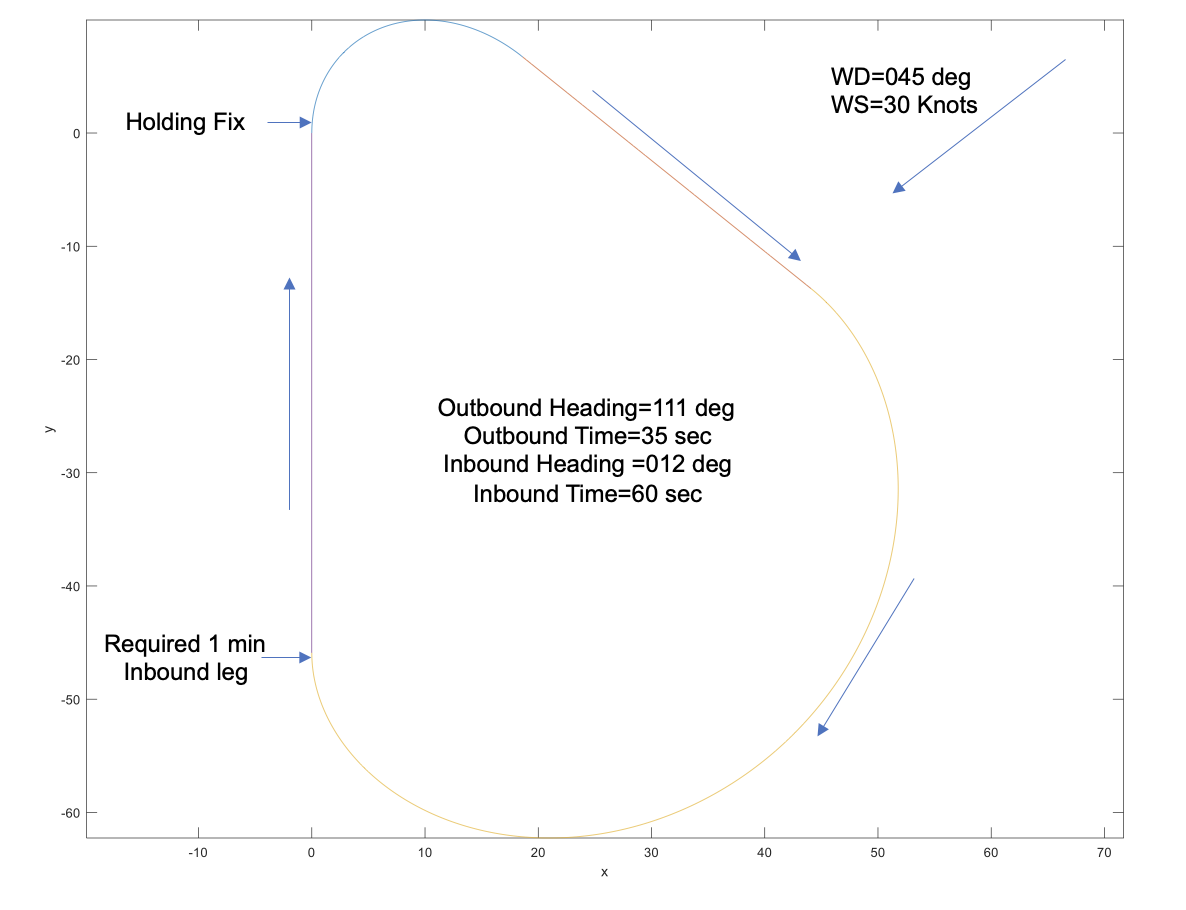March 31, 2021
L. Glatt, PhD, ATP CFI-AI
Objective
Comparison of FAA recommendation for holding pattern entries with new “High Precision Entry Method”
Results of this comparison show that under strong wind conditions
Pilot workload is increased in attempting to enter the holding pattern using the FAA recommended entry procedures
“High Precision Entry Method” reduces the Pilot workload by allowing the A/C ground track during the entry phase to smoothly blend into the ground track of the “Holding Pattern Solution”
This allows the A/C to intercept the holding radial at the required inbound time to the holding fix or required distance from the holding fix
Holding Pattern Scenario
Holding radial is 180 deg (360 deg inbound to the holding fix)
Standard hold (right turns)
Rate of turn 3 deg/sec (standard rate)
Inbound time to fix below 14000 MSL – 1 minute
Holding speed 100 KTAS
Wind direction 045
Wind speed 30 knots
Holding Pattern Solution for TAS=100 KTAS, WD=045, WS=30 Knots
Direct Entry Using FAA Recommendation
Aircraft heading to holding fix is 330 deg
FAA entry is a Direct entry
Aircraft turns outbound to heading of 180 deg for 60 sec
Aircraft turns inbound to roll out on heading of inbound course (360 deg) plus any wind correction angle (WCA on inbound course is 12 deg to the right, i.e. heading 012)
At completion of inbound turn track angle error is 26.3 deg
At this point the Pilot options are to either attempt to intercept the holding radial or proceed direct to the fix and start another Direct entry attempt
High Precision Entry into the Holding Pattern
Aircraft heading to holding fix is 330
High Precision Entry
A/C crosses holding fix and turns right to heading of 118 deg
A/C flies 118 deg for 46 sec
A/C roll into standard rate turn
A/C flight track during entry phase smoothly blends into ground track of “Holding Pattern Solution”
Pilot workload considerably reduced
FAA Recommendation for Teardrop Entry
Aircraft heading to holding fix is 165 deg
FAA entry is a Teardrop entry
After crossing the holding fix A/C turns left to heading of 150 deg for 60 sec
When A/C turns to heading 012 deg track angle error is 19.7 deg
At this point A/C options are to either attempt to intercept the holding radial or proceed direct to the fix and start a Direct entry attempt
High Precision Entry into the Holding Pattern
Aircraft heading to holding fix is 165 deg
High Precision Entry
A/C crosses holding fix and turns left to heading of 049 deg
A/C flies 049 deg for 12 sec
A/C rolls into standard rate turn to the right
A/C flight track smoothly blends into ground track of “Holding Pattern Solution”
Pilot workload considerably reduced
FAA Recommendation for Parallel Entry
Aircraft heading to holding fix is 205 deg
FAA entry is a Parallel entry
After crossing the holding fix A/C turns left to heading of 180 plus an additional 12 deg to compensate for wind (i.e. A/C parallels holding radial with heading of 168 deg) for 60 sec
Aircraft turns left and rolls out an intercept angle to the holding radial (i.e. 45 deg- A/C heading is 315 deg)
A/C intercepts holding radial and tracks inbound to holding fix
Inbound time to holding fix is 88 sec from point A/C intercepts holding radial
Target inbound time is 60 sec
High Precision Entry into the Holding Pattern
Aircraft heading to holding fix is 205 deg
High Precision Entry
A/C crosses holding fix and turns left to heading of 168 deg
A/C flies 168 deg for 41 sec
A/C rolls into a left standard rate turn and rolls out on a heading of 315 deg
A/C flies head 315 for 4 sec
A/C turns right to heading of 012 and tracks holding radial for required 1-minute inbound time to the holding fix
A/C flight track smoothly blends into ground track of “Holding Pattern Solution”
Pilot workload considerably reduced
Conclusions
New “High Precision Entry Method” allows Pilot to get established in the holding pattern by requiring the ground track of the entry procedure to smoothly blend into the ground track of the “Holding Pattern Solution”
Considerable reduction in Pilot workload
Holding entry and holding pattern can be flow with autopilot to allow Pilot to concentrate on situational awareness or having time to troubleshoot aircraft system problems while in the holding pattern








